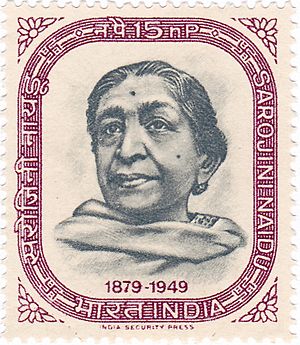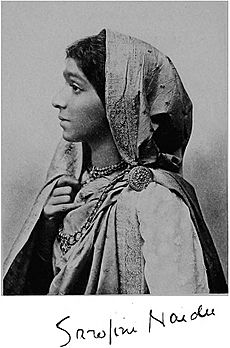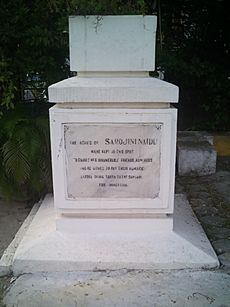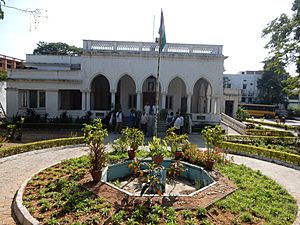Sarojini Naidu facts for kids
Quick facts for kids
Sarojini Naidu
|
|
|---|---|

Sarojini Naidu on a 1964 stamp of India
|
|
| 1st Governor of United Provinces | |
| In office 15 August 1947 – 2 March 1949 |
|
| Preceded by | Position established |
| Succeeded by | Hormasji Peroshaw Mody |
| President of Indian National Congress | |
| In office 1925–1926 |
|
| Preceded by | Mahatma Gandhi |
| Succeeded by | S. Srinivasa Iyengar |
| Personal details | |
| Born |
Sarojini Chattopadhyay
13 February 1879 Hyderabad, Hyderabad State, British India (now in Telangana, India) |
| Died | 2 March 1949 (aged 70) Lucknow, United Provinces, India |
| Political party | Indian National Congress |
| Spouse | Govindarajulu Naidu (1898–1949) |
| Children | 5; including Padmaja |
| Relatives |
|
| Alma mater | University of Madras King's College London Girton College, Cambridge |
| Occupation | Political activist, poet-writer |
| Writing career | |
| Language | English |
| Subject | Indian nationalism |
| Notable works | Golden Threshold; In the Bazaars of Hyderabad |
| Signature | |
Sarojini Naidu (born Sarojini Chattopadhyay; 13 February 1879 – 2 March 1949) was an amazing Indian leader and poet. She fought for civil rights (equal rights for everyone) and women's freedom. She also worked against colonialism (when one country rules another). Sarojini Naidu was a very important person in India's fight to become free from British rule.
Because of her beautiful poems, Mahatma Gandhi called her 'the Nightingale of India' or 'Bharat Kokila'. Her poems were full of color and wonderful images.
Sarojini was born into a Bengali family in Hyderabad. She studied in Madras, London, and Cambridge. After studying in England, she worked to help women get the right to vote. She then joined the Indian National Congress to help India gain independence. She became a follower of Mahatma Gandhi and his idea of swaraj (self-rule). In 1925, she became the President of the Indian National Congress. Later, in 1947, she became the Governor of the United Provinces. This made her the first woman to be a Governor in independent India.
Sarojini Naidu wrote poems for children and also on serious topics like patriotism, love, and sadness. Her poem "In the Bazaars of Hyderabad", published in 1912, is still one of her most famous works. She married Govindarajulu Naidu, a doctor, and they had five children. She passed away on 2 March 1949 from a cardiac arrest (heart attack).
Contents
Sarojini Naidu: India's Nightingale
Early Life and Family
Sarojini Naidu was born in Hyderabad. Her father, Aghorenath Chattopadhyay, was a Bengali Brahmin and the head of Nizam's College in Hyderabad. Her mother, Barada Sundari Devi Chattopadhyay, was also a poet who wrote in Bengali.
Sarojini was the oldest of eight children. Her brother Virendranath Chattopadhyay was a revolutionary, and another brother Harindranath was a poet, writer for plays, and an actor. Their family was well-known in Hyderabad. They were famous not just for leading Nizam College but also as artists. Being an artist during British rule was risky, but they followed their passions.
Her Education Journey
Sarojini Naidu finished her exams from the University of Madras when she was just twelve years old. After that, she took a four-year break from her studies.
In 1895, the Nizam of Hyderabad, Mahboob Ali Khan, gave her a special chance to study in England. She first studied at King's College, London and then at Girton College, Cambridge.
Her Marriage and Children
Sarojini met Paidipati Govindarajulu Naidu, a doctor, when she was 19. After finishing her studies, she married him. At that time, marriages between people from different social groups (called inter-caste marriages) were not very common. However, both their families approved of their marriage. Sarojini was from Bengal in Eastern India, and Paidipati Naidu was from Andhra in Southern India. So, it was also a marriage between two different regions and cultures.
The couple had five children. Their daughter Padmaja also joined the fight for India's independence. She was part of the Quit India Movement. After India became independent, Padmaja was appointed the Governor of the state of Uttar Pradesh.
Joining the Fight for Freedom
Sarojini Naidu joined the Indian independence movement after the division of Bengal in 1905. She soon met other important leaders like Gopal Krishna Gokhale, Rabindranath Tagore, and Mahatma Gandhi. These meetings inspired her to work for India's freedom from British rule and for social improvements.
Between 1915 and 1918, Naidu traveled all over India. She gave speeches about social welfare (helping people), women's freedom, and nationalism (love for one's country). In 1917, she also helped start the Women's Indian Association (WIA).
Later in 1917, Naidu went to London with her friend Annie Besant. Annie Besant was the president of the Home Rule League and the Women's Indian Association. They went to ask for universal suffrage, which means the right for everyone to vote.
In 1919, Naidu went to London again as part of the All India Home Rule League. She continued to speak up for India's freedom from British rule. When she returned to India in 1920, she joined Gandhi's Satyagraha Movement. This movement used peaceful resistance to protest against unfair laws. Naidu once said, "In the battle for liberty, fear is one unforgivable treachery and despair, the one unforgivable sin."
Naidu also led a meeting of the East African and Indian Congress in South Africa in 1929.
In 1930, Naidu was arrested along with other leaders like Gandhi and Jawaharlal Nehru. This happened because they took part in the Salt March. The Indian National Congress decided not to attend the First Round Table Conference in London because their leaders were in jail.
However, in 1931, Sarojini and other Congress leaders did take part in the Second Round Table Conference. This meeting was led by the Viceroy Lord Irwin, after the Gandhi-Irwin pact was signed.
Sarojini was one of the main leaders of the Civil Disobedience Movement and the Quit India Movement. Both movements were led by Mahatma Gandhi. She was arrested many times by the British and spent over 21 months (almost two years) in jail.
A Leader in Government
After India gained independence from British rule in 1947, Sarojini Naidu was chosen to be the governor of the United Provinces (which is now Uttar Pradesh). This made her India's first woman governor. She stayed in this important position until she passed away in March 1949, at the age of 70.
Her Amazing Poetry
Sarojini started writing when she was just 12 years old. She wrote a play called Maher Muneer in Persian, which impressed the Nizam (ruler) of Hyderabad.
In 1905, her first book of poems, called The Golden Threshold, was published. A famous writer named Arthur Symons wrote the introduction for it. Important Indian politicians like Gopal Krishna Gokhale loved her poems.
Naidu's famous poem "In the Bazaars of Hyderabad" was published in 1912 as part of her book The Bird of Time. Critics really liked "In the Bazaars of Hyderabad". They noted how Naidu used rich, vivid words to create strong images in her writing.
Another book of her poems, The Feather of The Dawn, was published after she died in 1961. Her daughter, Padmaja Naidu, edited and published it. Her poem "The Gift of India" is also well-known for showing patriotism and the real situation in India in 1915.
Last Years and Legacy
Sarojini Naidu passed away from a cardiac arrest (heart attack) on 2 March 1949, at the Government House in Lucknow. She had been advised by doctors to rest after returning from New Delhi on 15 February. Her health got much worse, and she died after a fit of coughing. Her last ceremonies were held at the Gomati River.
The English writer Aldous Huxley spoke about her political impact. He said that Sarojini Naidu had great intelligence, charm, courage, and humor. He felt that if all Indian politicians were like her, India would be very lucky.
Golden Threshold Building
The Golden Threshold is a building that belongs to the University of Hyderabad. It used to be the home of Sarojini Naidu's father, Aghorenath Chattopadhyay. He was the first head of Hyderabad College. The building was named after Sarojini Naidu's first collection of poems. Today, the Golden Threshold is home to the Sarojini Naidu School of Arts & Communication at the University of Hyderabad.
When the Chattopadhyay family lived there, it was a place where many new ideas for change were discussed in Hyderabad. These ideas covered topics like marriage, education, giving more power to women, literature, and nationalism. For example, they supported more power for women at a time when politics in India was mostly controlled by men. They also encouraged women to be involved in the arts. There were also many rules about marriage back then, like not marrying someone from a different region or social group. These ideas were very advanced for their time and slowly helped bring change to India.
Her Published Works
- 1905: The Golden Threshold, published in the United Kingdom (text available online)
- 1912: The Bird of Time: Songs of Life, Death & the Spring, published in London
- 1917: The Broken Wing: Songs of Love, Death and the Spring, including "The Gift of India" (first read in public in 1915)
- 1919: Muhammad Jinnah: An Ambassador of Unity
- 1943: The Sceptred Flute: Songs of India, published after she died
- 1961: The Feather of the Dawn, published after she died, edited by her daughter, Padmaja Naidu
- 1971: The Indian Weavers
Awards and Honors
The British government gave Naidu the Kaisar-i-Hind Medal for her work during a plague outbreak in India. However, she later returned this medal to protest the Jallianwala Bagh massacre in April 1919.
Sarojini Naidu's birthday, 13 February, is celebrated as Women's Day in India. This day honors the strong voices of women throughout India's history.
A documentary film about her life, called Sarojini Naidu (1960), was made by the Government of India's Films Division.
For her beautiful poetry, Naidu was given the special title "Nightingale of India".
In 2014, Google India celebrated Naidu's 135th birthday with a Google Doodle (a special drawing on their homepage). In 2018, the University of London in the United Kingdom included Naidu in their list of "150 Leading Women".
An asteroid, 5647 Sarojininaidu, was discovered in 1990 and named in her memory.
Images for kids
-
Drawing of Naidu by John Butler Yeats, 1896, from the front of her book The Golden Threshold (1905)
See also
 In Spanish: Sarojini Naidu para niños
In Spanish: Sarojini Naidu para niños







